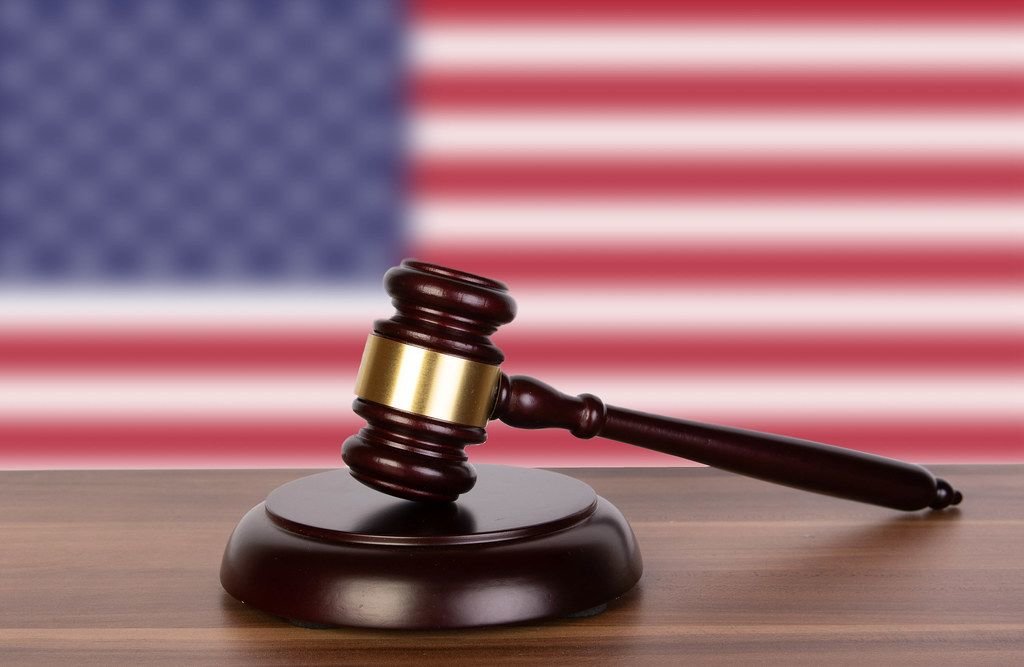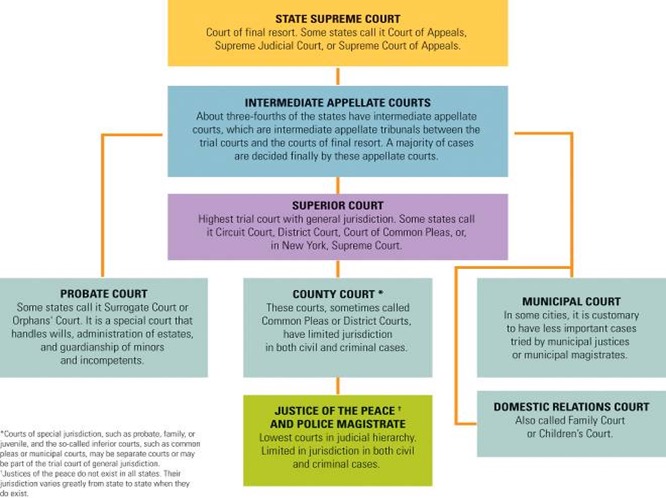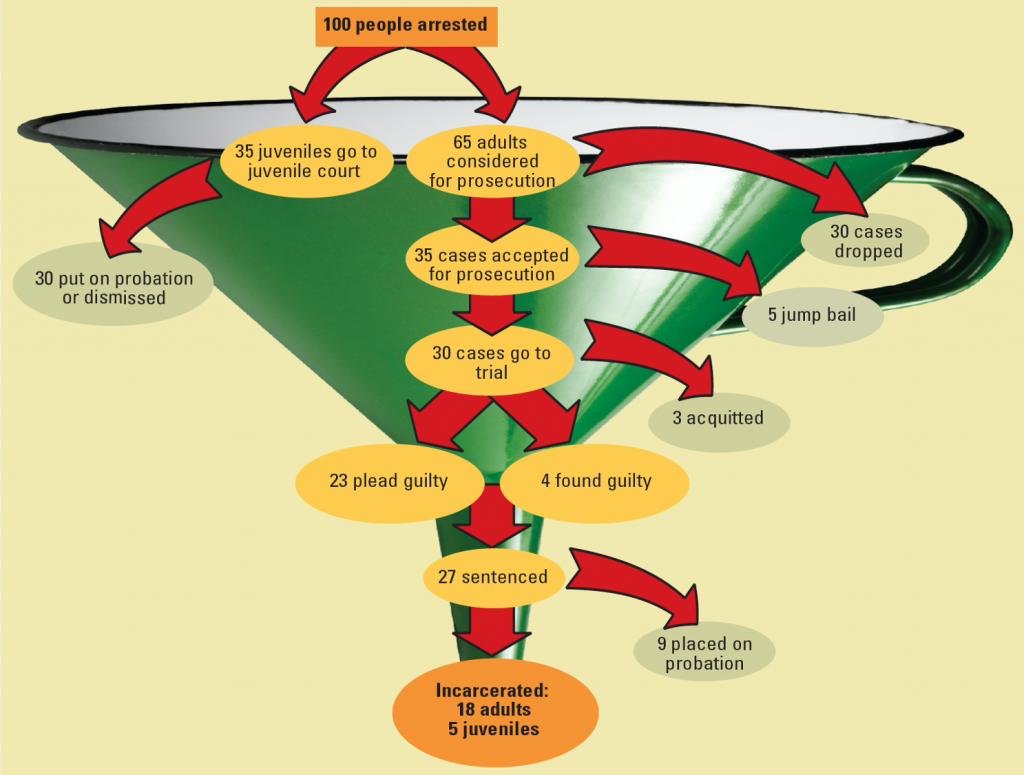Chapter Three: Courts in the United States
Chapter Three: Courts in the United States

Author: Marco Verch
Source
This image is licensed under CC-BY 2.0
Project for this Section
Case Brief
Court Cases: Look up the following cases and bring them to class on due date noted in syllabus. I would recommend using this website. Those submitted that are incomplete or missing cases/sections will be an automatic zero. Those late will also be a zero; the due date is at the start of class. No Exceptions. Any blanks on any case will result in a zero for all cases. Do not wait until the last minute to look at this.
- Mapp v Ohio (1961)
- Gideon v Wainwright (1963)
- Tinker v Des Moines (1969)
- Miranda v Arizona (1966)
Sections of the Brief
Facts of the case:
In this section you will identify the key players in the case and the reason the case in court. For example in MAPP V OHIO you will need to identify who is MAPP and what is the connection with the state of OHIO? This will need to be in paragraph form and in YOUR OWN WORDS, DO NOT COPY AND PASTE.
Issues
Each of the cases that are assigned deal with and Amendment Issue. In this section you will need to identify what amendment’s are being addressed and why?
Decisions
This is where you will note what the final vote was in the case. In all cases the vote with the most majority is the winner of the trial.
Reasoning
Separate Opinions
At the end of every case you will see concurring and dissenting opinions. You will need to summarize the one that has the majority. Hint – it has more judges names listed before it.
Analysis
How did this case change life for future generations?
Terms
Path-models of the systems in the United States
Typical State Systems
Magistrate
A public civil official with limited authority and jurisdiction and in a particular geographic area. She/he will hear and decide cases and issue warrants.
PA Court System
- Supreme Court
- Highest court in Pa
- Superior Court
- Criminal and Civil Appeals
- Hears cases on matters involving children and families
- Commonwealth Court
- Case against the Commonwealth
- Common Pleas
- All Major Criminal and Civil Cases
- Special Courts
- Less Serious, non criminal, civil and all traffic matters
- Matters pertaining to bail
- What cases need to move up such as murder
Case Flow in PA
Criminal Case Flow
- Crime occurs
- Arrest takes place
- Preliminary Hearing to see if trial is needed
- Trial takes place OR defendant pleas
- If there is a conviction a sentencing hearing is scheduled
- Defendant can appeal conviction to the Superior Court
Civil Case Flow
- Dispute Develops
- Complaint is filed and then served to both parties
- Defendant files an answer
- Both sides gather evidence
- Pre-trial conference takes place between attorneys and judge
- If no settlement then a trial takes place
- Either party can appeal the decision to the appellate court
United States Supreme Court
- Reviews only 5% of the cases decided in the country
- The court has addressed every important facet of criminal law
- Supreme Court makes Criminal Justice Policy in Two important ways
- Judicial Review
- Authority to interpret the law
- Writ of Certiorari
- A request from a high court asking the lower court for the record of a case.
- Rule of 4
- A writ will not be issued unless 4 Justices approve the case
Oral Arguments
Verbal arguments presented in person by attorneys to a court.
Concurring Opinions
Separate opinions prepared by judges who support the decision of the majority
Dissenting Opinion
Separate opinion in which the judges disagree with the majority and what to expand on why.
During Pre-trial Detention
Initial Appearance
An accused first appearance before a judge following an arrest. Informed of charges, advised of right to counsel, told of the bail amount, and provided follow up date for preliminary hearing.
Bail
Amount or conditions set by the court to ensure that and individual accused of a crime will appear for further criminal proceedings. If met you can go home.
Purpose of Bail
Provided under the 8th Amendment “excessive bail shall not be required” but does not mean the defendants ability to pay.
Steps to Trial
- Arrest
- Booking – searched, photo, fingerprinted and allowed 1 phone call.
- Initial Appearance – Judge tells you what you are being charged with, seek counsel, bail is set.
- Grand Jury – Determines if there is probable cause to believe that the defendant committed the crime. (federal)
- Preliminarily Hearing – the prosecutor presents the evidence and the judge determines if there is probable cause to hold the defendant over for a trial.
- Indictment – charging instrument that is issued by Grand Jury
- Information – Charging instrument issued by the prosecutor
- Arraignment – brought before a judge and told of charges and asked to enter a plea
- Plea Bargain – Prosecutors promise that in return for your guilty plea you will get less charges or reduced time.
- Guilty Plea – The judge sets date for sentencing
- Trial – if the defendant does not plead guilty he/she will go to trial.
Setting Bail
- Uncertainty
- Risk
- Overcrowded Jails
- Average Bail Amounts per crime last year
- Murder – 250,00
- Rape – 30,000
- Robbery – 25,000*Assault – 10,000
- Drug Charge – 7,500
- Pretrial Release
- ROR – Released on own Recognizance
- Judges order that releases an accused from jail with the understanding that he/she will return for further proceedings.
- Most ROR do NOT go to trial – Victimless crimes
Bail bondsperson
Business person who agrees for a fee to pay the bail amount if the accused fails to appear in court as ordered.
Preventive Detention
Retention of an accused person in custody due to fears that he/she will commit a crime if released before trial.
Discovery
Formal investigation, prior to trial the defense uses various methods to obtain information from the prosecution to prepare trial.
Case Attrition
Prosecutors, by deciding whether or not to prosecute each person arrested effect of overall reduction in the number of persons prosecuted.
Defenses and Justifications
Defense
Evidence and arguments offered by a defendant and his/her attorney to show why that person should not be held liable for the charges
Defense built on 4 bases
- Alibi
- Inability
- Justification
- Excuse
Justifications
Defendant admits committing the act in question but claims it was necessary in order to avoid some greater evil.
Meaning – the benefits outweigh the harm.
Examples: Self Defense and Entrapment
Excuses
Defendant claims that some personal condition or circumstance at the time of the act makes them unaccountable under criminal law.
They will admit the harm but claims absence of ability.
Example:
Justifications as a Defense
- Necessity
- Self Defense
- Defense of others
- Defense of home and property
- Resisting unlawful arrest
- Consent
Necessity
- Claims that it was needed to commit some unlawful actin order to prevent or avoid a greater harm.
- Regina V Dudley and Stephen
- Fire
- Steals
- Drugs
Self Defense
A person has an inherent right to self – protection and that to reasonably defend oneself from unlawful attack is a natural response to threatening situations.
- Mens Rea – Defendant did not mean or intend to kill but instead was preserving his/her own life.
- Concept of Reasonable Person – The accused should act under the same under similar circumstances.
- Reasonable Person – Acts with common sense and a mental capacity of average.
- Apparent Danger – Conduct or activity of the attacker makes the threat of danger obvious.
- Danger
- When a threatening person draws a gun or knife, immediacy of action is required.
- Take into your own hands
- Do not show Vengeance
- Victim had it coming does not work
- Danger
Force
- Reasonable force
- A degree of force that is appropriate in a given situation and I not excessive.
- Minimum to protect ones self, property in the face of a threat.
- Pocket
- If someone is making verbal threats and then proceeds to place hands in pocket, you are able to use reasonable force to protect yourself.
- Deadly Force
- Force likely to cause death or great bodily harm, can not be used against undeadly force, once the person is down and no longer a threat it is illegal to pursue further course of action
Rape Occurence
- 1997 a women was raped and severely beaten. After stealing all her money the rapist forced the women in the car and to drive him out of town
- When she gets in the car she locks all the doors and runs over her rapist multiple times.
- After being taken to the hospital she was charged with assault with a deadly weapon
Precipitate or incite
- People who do this are not able to claim self defense
- Person being attacked must retreat in order to avoid the necessity of using force against the attacker
- Only 2 places this rule does not exist is your home or work
- Claim of self defense that meets all the requirement’s and conditions to be valid. Death must prove imminent or fear of death.
Defense of Others
- Alter Ego Rule
- Can only defend the third party under circumstances and only to the degree that the third party could act on their behalf
- Defense will not work for:
- A family member who helps another win a fight
Defense of Home and Property
-
- Protection of Personal Property
- Human life outweighs any type or form of property
- Defense of home and habitation
- Robber – If a robber has a weapon then lethal force is appropriate
- Defense of another property
- NO BOOBY TRAPS
- Bear Claws, cement mail box etc.
- Protection of Personal Property
- Castle Exception
- Exception to the retreat rule that recognizes a person fundamental right to be in his or her home as a final place of retreat.
Unlawful Arrest
- Public Duty
- Possibility of police officers and other public employees from being prosecuted when lawfully exercising their authority
- Officers
- Are not required to retreat instead of making an arrest
- Fleeing felon Rule
- Defunct law – allowing officers to shoot a suspect felon who attempted to flee lawful arrest
- Tennessee V Garner – Constitutionally is unreasonable
Consent
- Sports
- Tackling in football – common
- Tackling in Tennis = NOT COMMON
- Assault
- Beyond Normal
- Fighting ref in boxing match or ref in basketball game.
- Sexual Consent
- Sexual consent for advances is not the same as consent to intercourse.
- When can one stop consent
- Consent During Sex
- Robert Chambers
-
Expressed Consent
-
Verbally expressed willingness to engage in an activity
-
-
Homicide
-
A person states go ahead and shoot me.
-
Does this give you consent to kill them?
-
-




